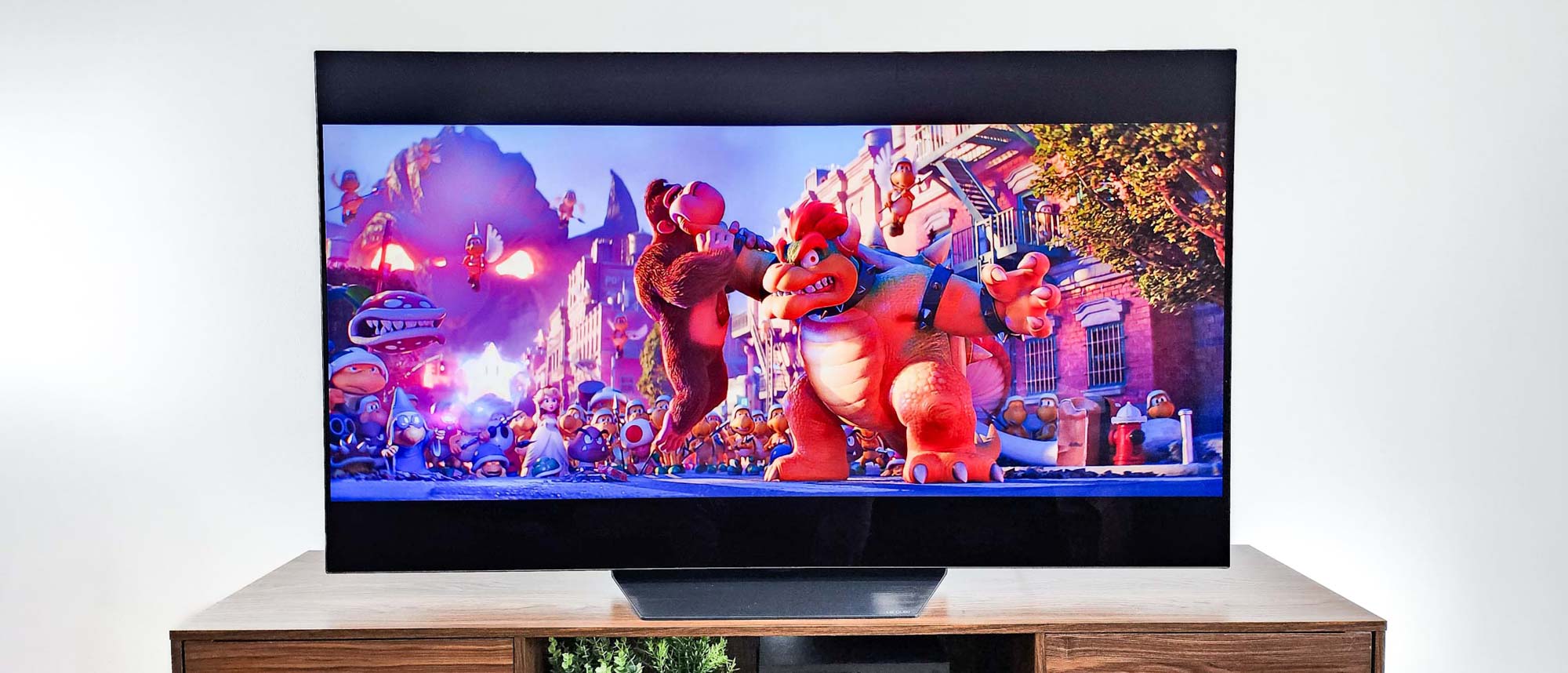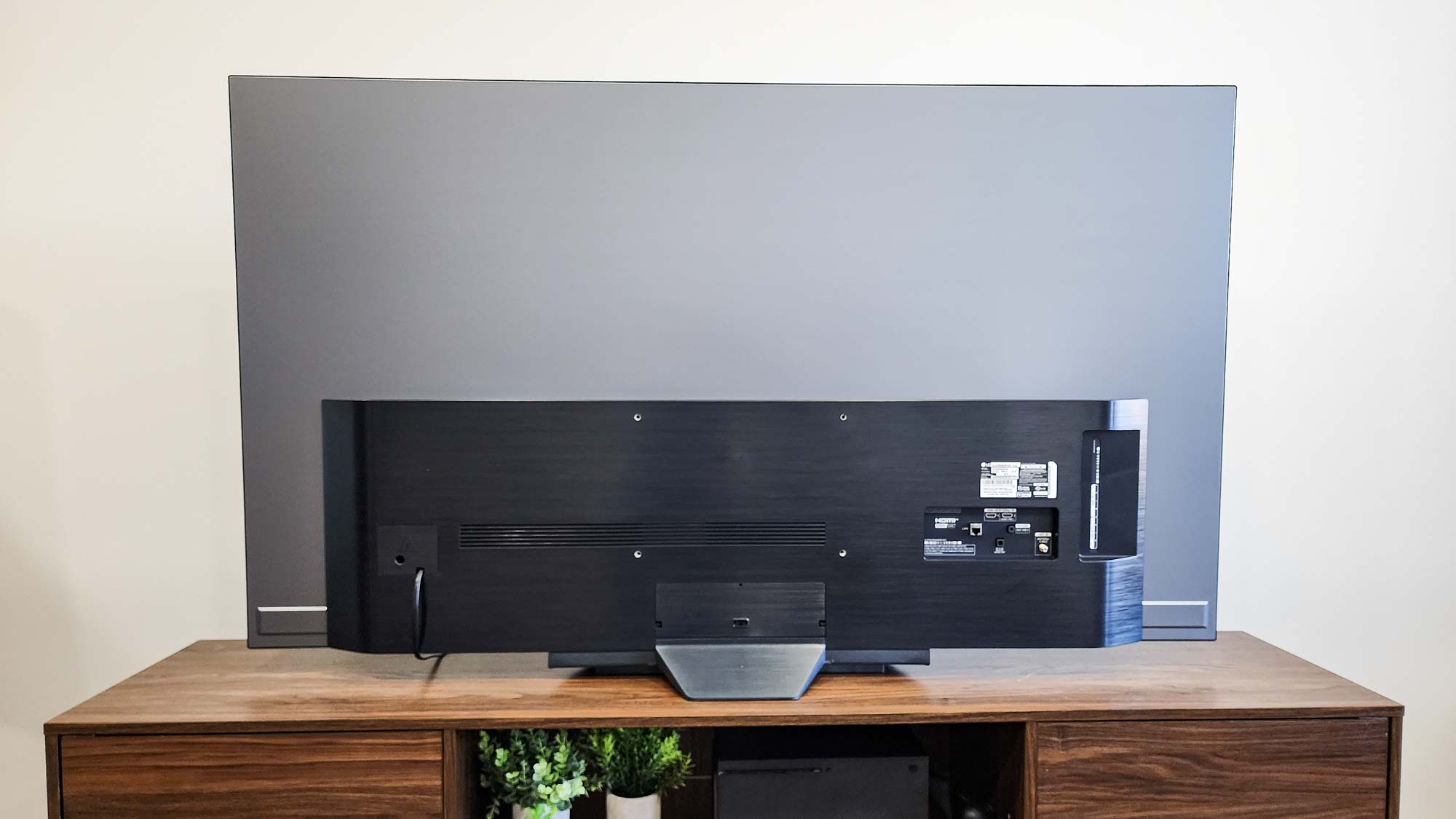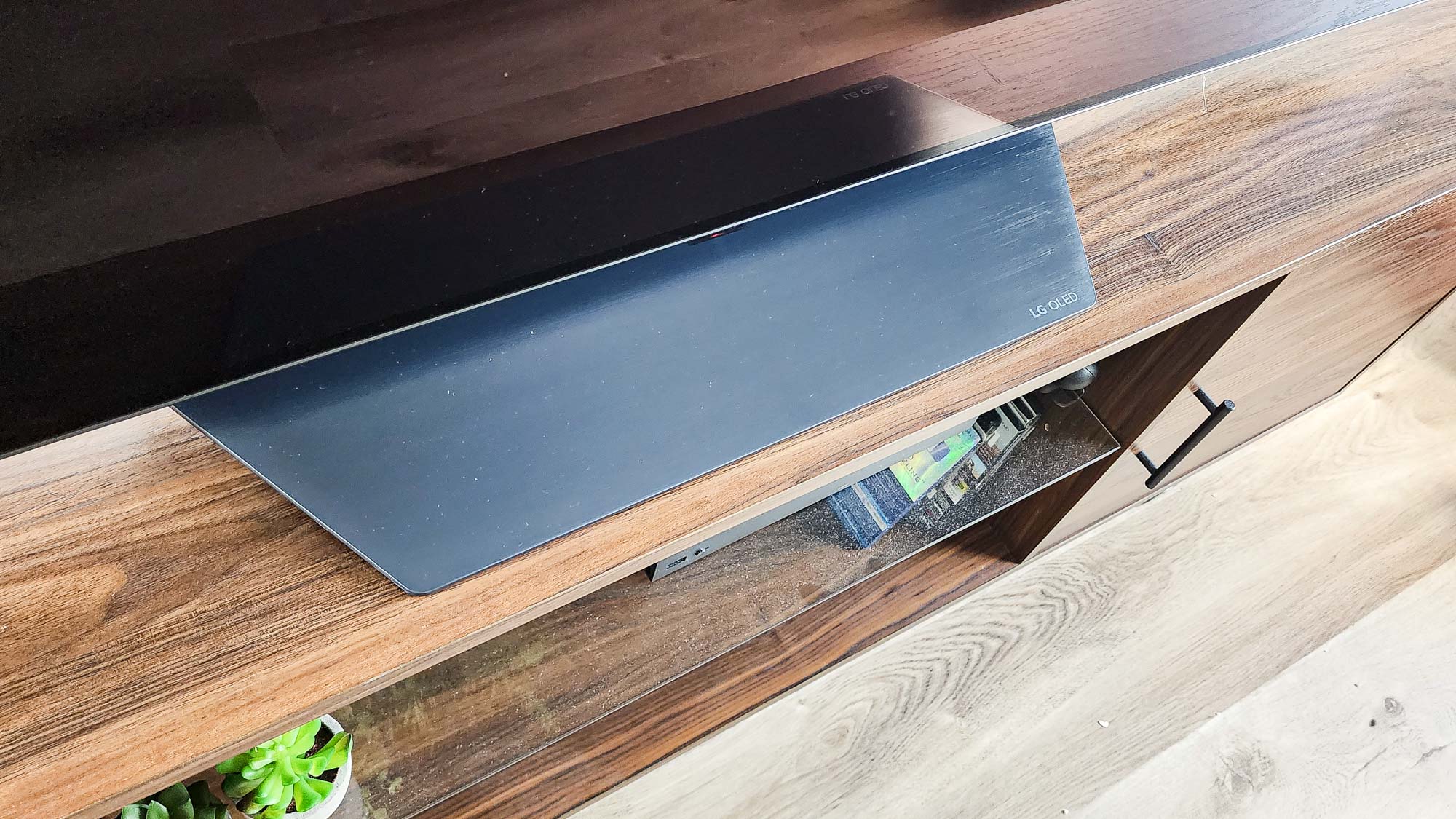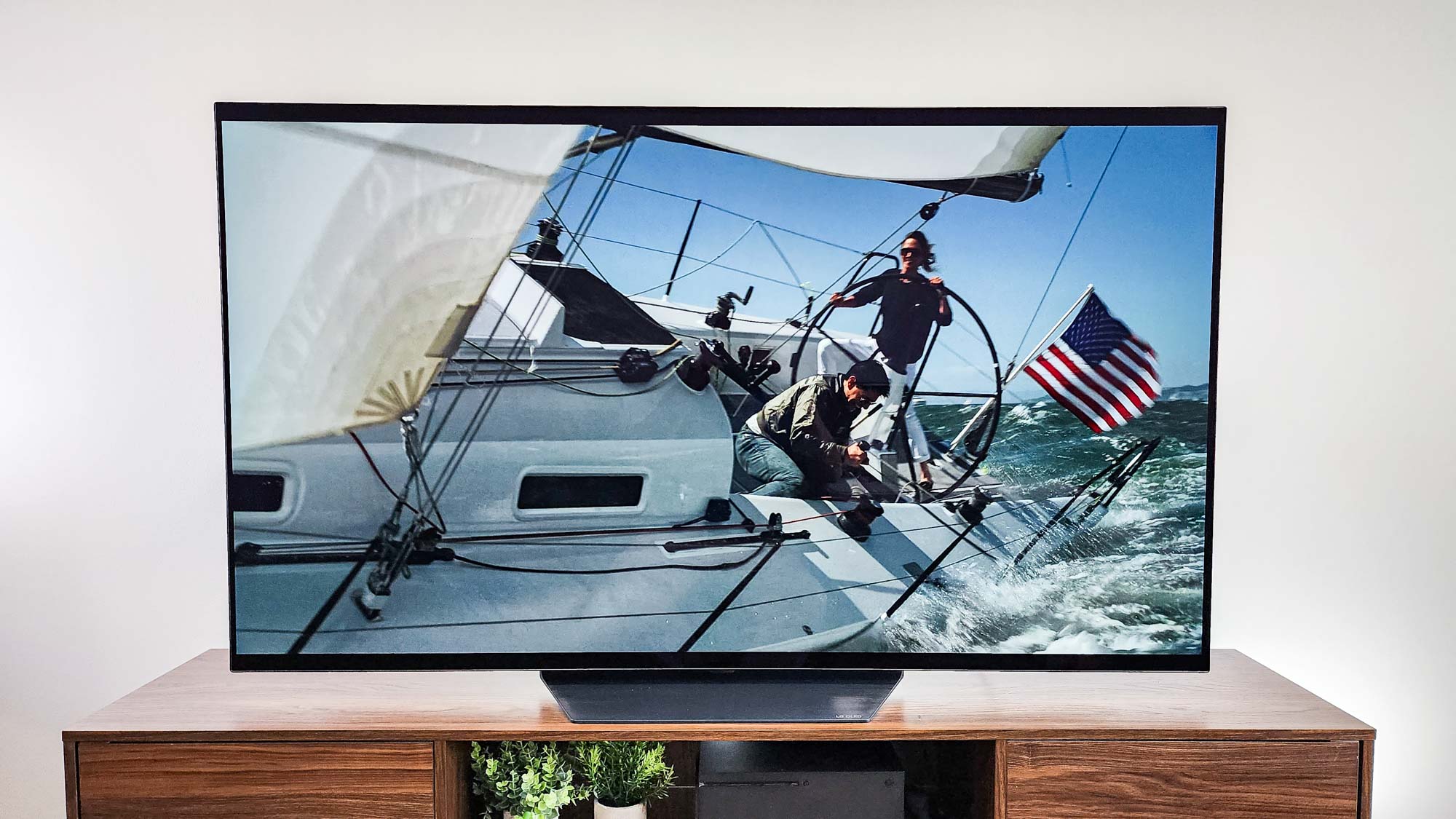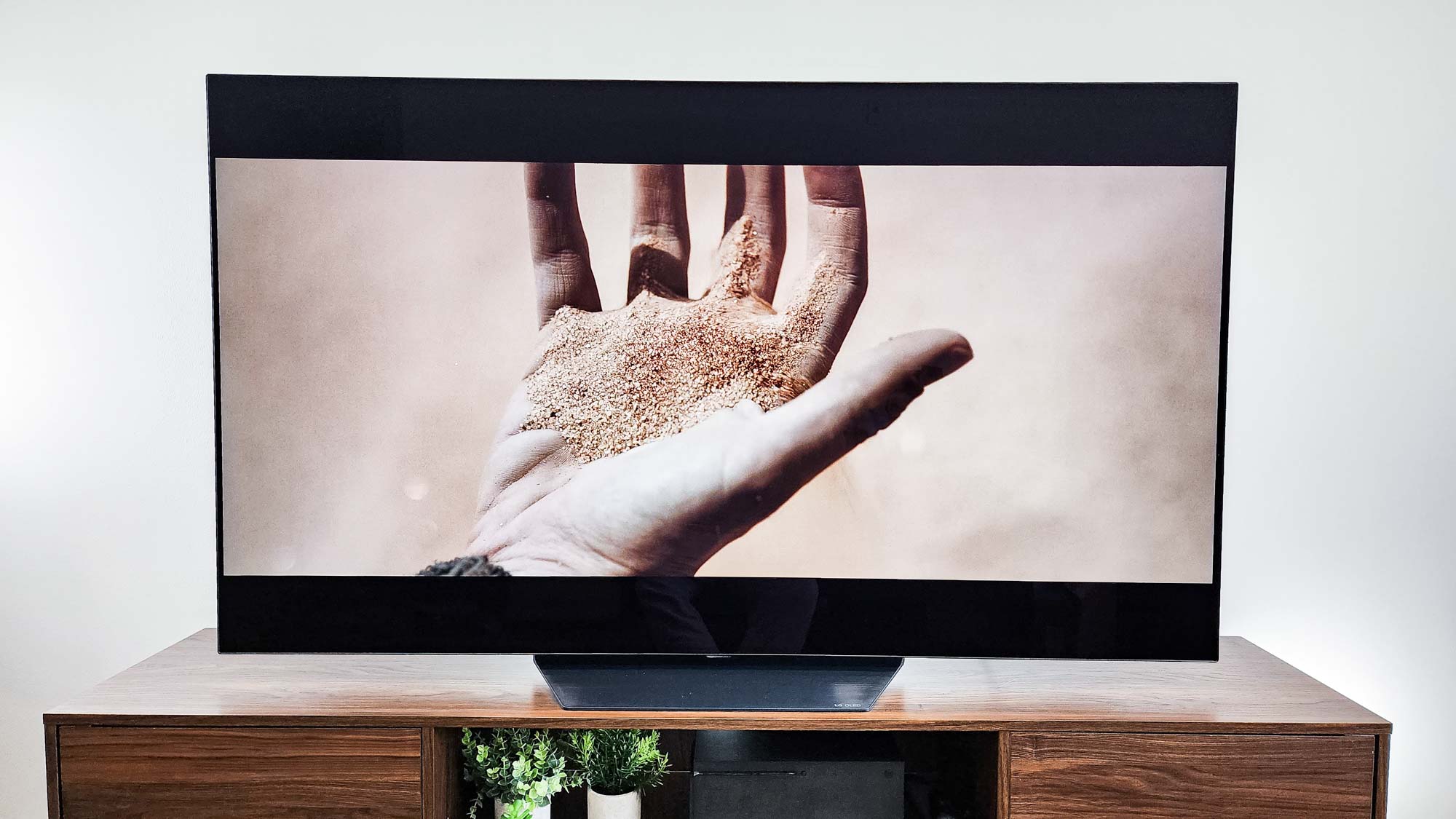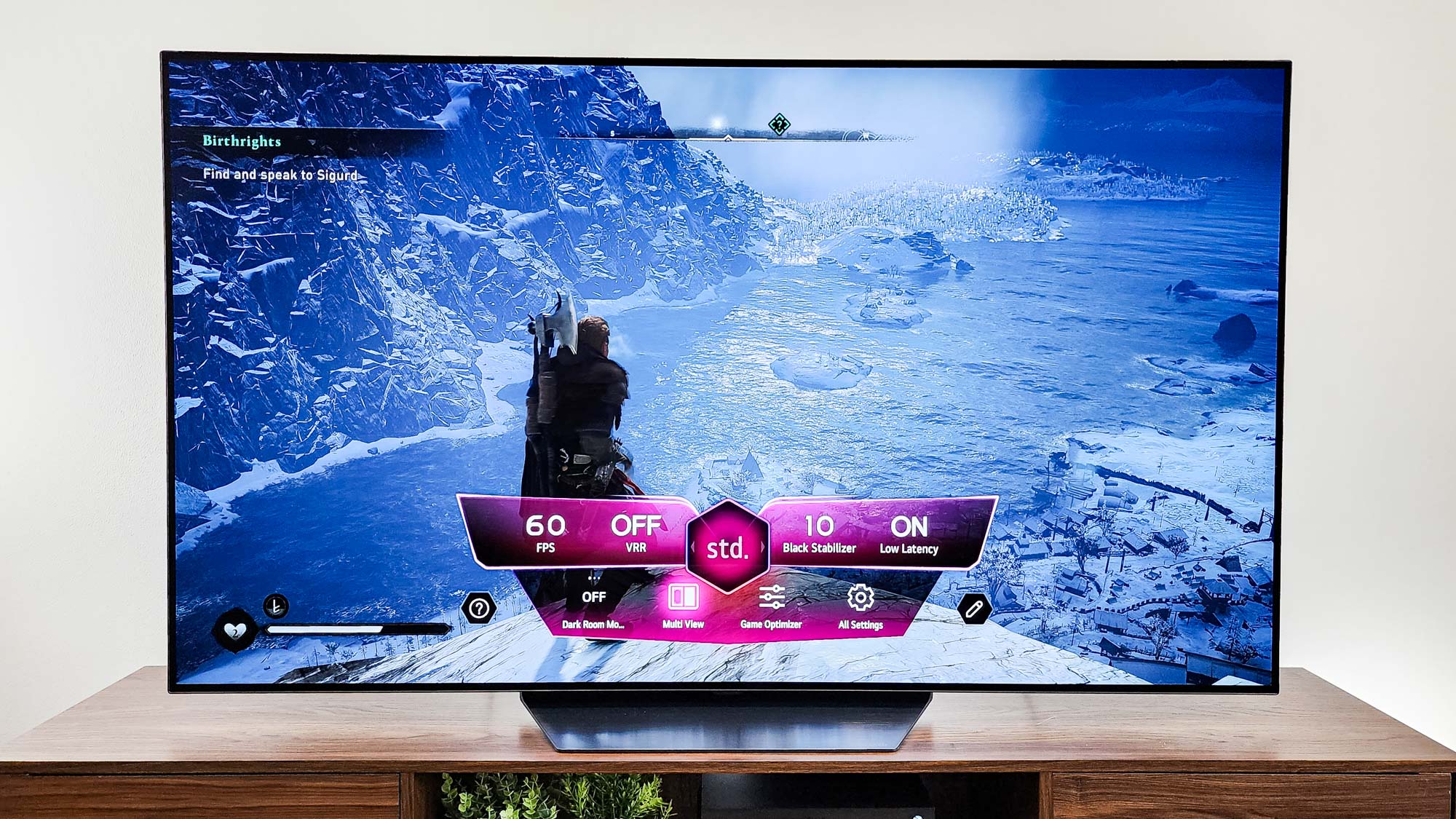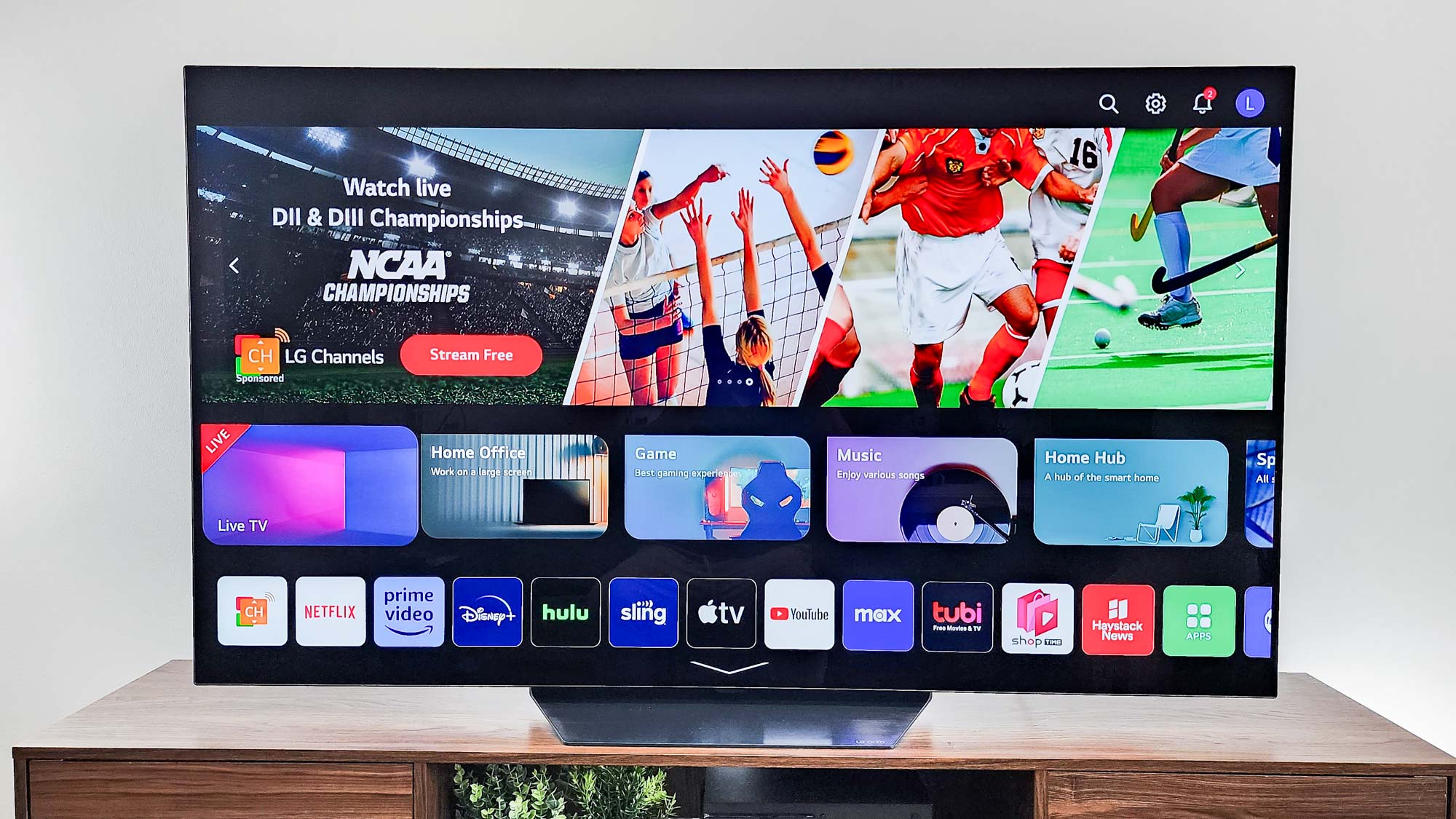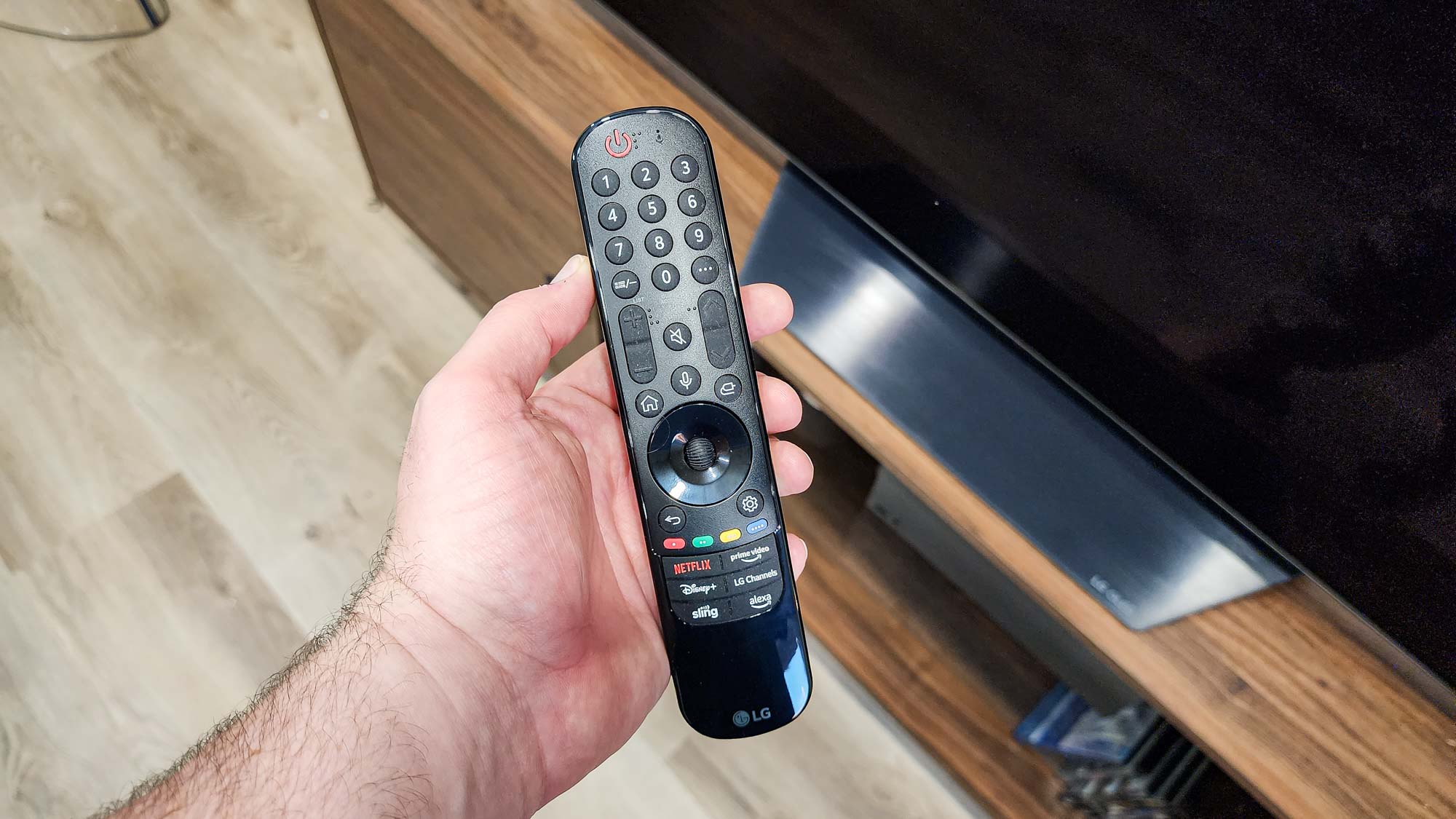Tom's Guide Verdict
With strong color, low input lag and a bevy of other features, the LG B3 OLED blows away its competitors to become one of the best value OLED TVs on the market based on our testing. Only its low brightness holds it back from greatness.
Pros
- +
Excellent color performance
- +
Low input lag
- +
Top-notch smart interface
Cons
- -
So-so brightness
- -
Sound could be better
Why you can trust Tom's Guide
Price: $1,299.99
Screen size: 65-inch
Model: OLED65B3PUA
Resolution: 3,840x2,160
HDR: HDR10, Dolby Vision, HLG
Refresh Rate: 120Hz
Ports: 2 USB, 2 HDMI 2.0, 2 HDMI 2.1
Audio: 20W
Smart TV Software: webOS 23
Size (without stand): 57x32.8x1.8 inches
Weight (without stand): 52.9 lbs.
The LG B3 is the lower-midrange extension of LG’s acclaimed OLED TV line, slotting in below the C3. But though a simplified version of that more expensive model, the B3 is, in its way, every bit as impressive. Its top-tier color results in an outstanding picture. It’s loaded with features that make the TV both easy and fun to use, from its low input lag to its excellent smart interface. And it rings in at a price low enough to more than make up for the little you’re not getting.
That’s primarily brightness, which even with HDR video isn’t that high, and you’ll have to make a couple of other minor sacrifices. But no TV this inexpensive is going to have everything, and what the B3 does have — and the price at which you can have it — emphatically brands it as one of the best TVs you can buy.
LG B3 OLED review: News and updates
The LG B3 OLED remains one of the best budget OLED TVs you can buy, but LG isn't resting on its laurels. In 2024, LG plans to release an LG B4 OLED model that upgrades the processor inside the TV. Changes won't be widespread, but it will be worth looking at when the B4 OLED becomes available in mid-2024.
LG B3 OLED review: Pricing and availability
The B3 is available in three sizes:
- LG OLED55B3PUA (55 inches): $1,199.99
- LG OLED65B3PUA (65 inches): $1,299.99
- LG OLED77B3PUA (77 inches): $1,799.99
As all three sizes use nearly identical panel technology and sport the same collections of features, we expect them to all perform similarly.
LG B3 OLED review: Design
Like most OLED TVs on the market, the B3 boasts an incredibly thin screen (a hair past one-eighth inch thick) and an ultra-narrow bezel to further complement its already svelte profile. The bezel is thin on all four sides of the screen, a departure from many TV designs, with the only ornamentation on the bottom, where the central IR emitter also obscures a hardware button that lets you adjust Power, inputs, Volume, and Channel without needing the remote.
The set as a whole measures 1.8 inches as its thickest point (toward the bottom, where the rear control box sits on the rear panel), but its other dimensions (57x32.8 inches) and weight (52.9 pounds) mean that moving and setting it up by yourself are likely to be tricky. Another pair of hands is basically a must if you want to keep you and your TV safe.
Get instant access to breaking news, the hottest reviews, great deals and helpful tips.
You can mount the B3 on the wall using the 300x200 VESA holes on the stylish but Spartan gray rear panel (here are our recommendations for the best TV mounts), or you can display the TV on a table or entertainment center by connecting the included stand.
A single unit that attaches with four screws, it’s an attractive, brushed-metal, foot-style stand positioned in the middle of the TV’s lower edge — almost the same design as we saw with the C3 and the G3 (though with the latter, the stand was a separate purchase).
LG B3 OLED review: Ports
Even on its lower-end OLED, LG doesn’t skimp on the ports or diminish their convenience. On the TV’s left edge are the two USB ports and two HDMI ports, all for the things you’re apt to connect and disconnect regularly. Facing straight back on the TV’s rear panel are the harder-to-access ports you’ll want to use for your permanent cables: LAN, S/PDIF optical audio out, a coaxial cable connector, and two more HDMI ports (one of which is equipped with eARC).

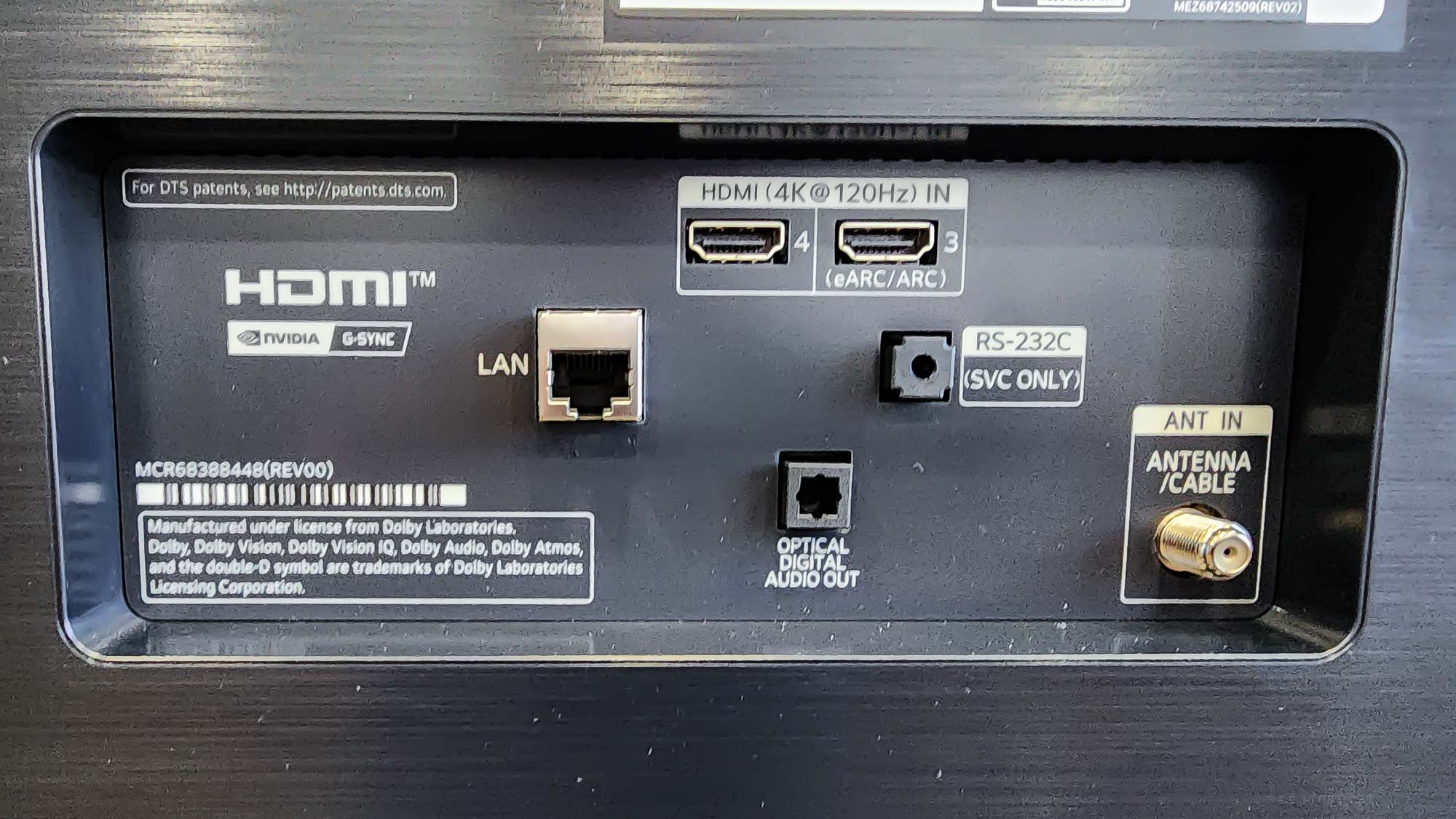
Only the latter two conform to the newer HDMI 2.1 specification, which has greater bandwidth to make possible 4K at 120Hz and features such as Variable Refresh Rate (VRR) and Auto Low-Latency Mode (ALLM) of primary interest to gamers (see that section below for more). Although any number of HDMI 2.1 ports is better than none, we still wish the B3 were more like the C3 and the G3, which use it on all ports rather than just some.
LG B3 OLED review: How we test
For every TV we review at Tom’s Guide, we conduct a series of technical and subjective tests designed to measure the set’s performance. For our technical tests, we use an X-Rite i1 Pro spectrophotometer, a SpectraCal VideoForge Pro pattern generator, and Portrait Displays’ Calman TV-calibration software, and we add a Leo Bodnar 4K Input Lag Tester for measuring the TV’s gaming prowess. Subjective tests vary based on the reviewer, but typically include a diverse selection of movies, TV shows, and other content reflecting the types of things you may actually want to watch on the TV.
For a more detailed look at what we do and how we do it, check out our “How We Test TVs” page.
LG B3 OLED review: Performance
TV buyers—especially movie buffs—prize OLED TVs because of their perfect blacks, infinite contrast, and sumptuous colors that give everything a deeper, more elegant, and more realistic look. All of that is certainly true of the B3, with content of all types looking richer and more exciting than even brighter LCD sets frequently match.
We watched our usual test library of recent movies, including Mission: Impossible—Dead Reckoning Part One, The Super Mario Bros. Movie, Avatar: The Way of Water, Top Gun: Maverick, The Batman, and Dune Part One, and they were all gorgeous and satisfying. The action movies had the proper tense, dynamic look and hard-throttling energy, and the more heavily animated titles with sprawling color palettes (primarily blues and greens for The Way of Water, the full Rainbow Road for Super Mario Bros.) leapt off the screen.
Many sections of The Batman depend on black-on-black action, and we didn’t have any trouble discerning any of the picture elements as displayed on the screen, and from any viewing angle (another major OLED benefit).
The one issue we experienced wasn’t due to the display technology—at least not directly. Check out the next section for more details, but whereas many competing sets are bright enough to cut through external glare, the B3 falls short, and your movie may fight with other lights in your living room (or the sun) for your eyes’ attention.
This was at its most distracting with dark scenes (cue The Batman again, but also Dune), and you might not notice it much at other times. You can significantly ameliorate the effects by watching in the dark, but regardless, your lighting and window configuration may play a critical role in figuring out the best placement for the B3.
LG B3 OLED review: Test Results
Brightness is often a determining factor with lower-cost TVs, and, as stated above, it’s where the B3 stumbles most. Interestingly, its SDR brightness is on a par with that of other comparable sets such as the Samsung QN90C and the Sony A80L (and, for that matter, even the C3), but there’s a big jump with HDR that leaves the B3 alone in a bad way. No OLED sets are going to compete with the likes of QLED models, of course (the QN90C and the TCL QM8 are more than three times as bright), but even so, the B3 is on the low side.
| Row 0 - Cell 0 | LG B3 | LG C3 | Samsung QN90C | Sony A80L | TCL QM8 |
| SDR Brightness (10%, in nits) | 236 | 237 | 226 | 224 | 1348 |
| Delta-E (lower is better) | 1.8943 | 1.3908 | 2.2404 | 3.3797 | 3.232 |
| Rec. 709 Gamut Coverage | 99.9724 | 99.0904 | 99.1894 | 109.529 | 97.5132 |
| HDR Brightness (10%, in nits) | 635 | 820 | 1987 | 676 | 2201 |
| UHDA-P3 Gamut Coverage | 99.07 | 98.98 | 94.13 | 99.08 | 97.2 |
| Rec. 2020 Gamut Coverage | 73.87 | 73.77 | 73.33 | 73.27 | 76.58 |
| Input Lag (ms) | 12.7/10.1 | 12.9/9.1 | 9.7 | 16.3 | 13.0 |
| Row 8 - Cell 0 | Row 8 - Cell 1 | Row 8 - Cell 2 | Row 8 - Cell 3 | Row 8 - Cell 4 | Row 8 - Cell 5 |
Color is a more interesting and more positive story. Both the B3’s Delta-E (which measures the difference in color between what the source sends and what the screen displays, with lower values being better) and its coverage of the Rec. 709, UHDA-P3, and the Rec. 2020 color gamuts are about as good as you’ll find: Only the Sony A80L really competes across the board, and its SDR colors are oversaturated and its Rec. 2020 coverage just a shade behind the B3 (and the QN90C).
These may not be record-setting numbers, but they’re reminders that just because a TV falters in one area doesn’t mean it won’t excel in another. If you can address the B3’s brightness limitations, you won’t be disappointed by anything else.
LG B3 OLED review: Audio
Although LG TVs are acclaimed by many (including us) for their picture quality, their audio systems usually leave quite a bit to be desired. The B3 is no exception to this, with its downward-firing, 2.0-channel, 20W speaker system turning out gratingly anemic audio.
In addition to producing no bass response worth discussing (with the opening section of The Knife’s “Silent Shout” roundly one-dimensional in every particular), its higher trebles are shrill, too, with the high B-flat at the end of our soprano vocal track taking on a staticky, distorted sheen that obscures the natural beauty of the human voice.
Movies, TV series, and games sound okay (provided you keep the volume below the halfway mark), but the shallow nature of the sound will never cause the hairs on the back of your neck to tingle. If audio quality is important to you, consider putting some of the money you save from buying the B3 toward one of Tom’s Guide’s best soundbars.
LG B3 OLED review: Gaming
When evaluating a TV’s gaming prowess, we look for input lag at least below 20ms and preferably below 10ms. In its default settings in Game Mode, the B3 satisfies the former condition with lag of 12.7ms (the lowest of any of LG’s current TVs). When the Boost function is enabled in LG’s Game Optimizer, the lag drops to 10.1ms—not quite as low as the Samsung QN90C or LG’s higher-end sets, but enough to guarantee the smooth control you’re looking for with a console title. We experienced no issues at all when test playing Assassin’s Creed Valhalla and Starfield.
The two HDMI 2.1 ports allow for 4K gaming (including with Dolby Vision) at up to 120Hz, and support for technologies like AMD’s FreeSync and Nvidia’s G-Sync tear-reduction systems. ALLM (which automatically activates the game mode when a console is connected), and VRR (which matches the TV’s refresh rate to that of the source to further reduce tearing) further sweetens the pot.
Game Optimizer, by the way, provides a wealth of information in its game bar at the bottom of the screen and gives you an array of additional configuration options through its menus to tweak scene elements, specify the game’s genre to fine-tune your experience, and more. Its selection isn’t quite as fun as Sony’s, but that’s understandable as LG isn’t trying to sell you on a PS5 console, too. And it’s still more than enough to add a lot of value and ease to your gaming experience.
LG B3 OLED review: Smart features
LG has not been swayed by the advent (and rapid proliferation) of the excellent Google TV smart interface and has instead stuck with its own webOS 23. If it lacks the rigorous interoperability of Google’s solution, webOS is still, for my money, the second best out there: clean, clear, and easily navigable.
A carousel at the top of the screen surfaces a number of current entertainment choices, many of which tend to be found through the LG Channels service. Below that are five “cards,” or collections of items targeting functionality for the Home Office (such as using Windows 365, various Google Workspace apps, and remote PC controls), Game (for switching between consoles and tracking down online titles), Music (combining YouTube, Spotify, and other services with casting choices), Home Hub (for connecting and operating your home IoT devices, activating Apple AirPlay, and the like), Sports (where you can register your favorite team or player to get personalized content), and Tips (for making the most of the TV’s capabilities). Next is the fully customizable app bar, then various curated collections you can probably ignore. You can also search by voice, and support for Amazon Alexa, Apple HomeKit, and Google Assistant gives you more methods of smart interaction with the B3.
Like a lot of manufacturers’ proprietary streaming services, LG Channels somehow manages to be both overstuffed and negligible. It brings together live and on-demand choices from more than 150 IPTV channels in a variety of genres (news, sports, movies, and so on), though without the crisp organization and powerful search capabilities of something like YouTube TV. That it’s all free is a plus, to be sure, but unless you lack subscriptions to other streaming services, you’ll mostly get what you paid for.
LG B3 OLED review: Remote
LG’s Magic Remote has not changed in design over the last few years, but it hasn’t needed to, and it still lives up to its name. The main button deck has a matte black finish, and the underside is glossy but thanks to the shape, somehow still easy to hold. The dense collection of buttons includes a full number keypad (rare from major TV makers these days), color buttons, and shortcut keys for Netflix, Amazon Prime Video, Disney+, LG Channels, Sling, and Amazon Alexa, along with all the other controls you’d expect.
The “magic” comes by way of the integrated mouse-style pointer that lets you click buttons by waving around the remote and pressing the OK button at the center of the control pad. This remains better in concept than theory, as the pointer’s jittery nature makes it difficult to control precisely and the button’s extra scroll-wheel functionality adds an extra layer of complexity just to clicking. I’ve found myself invariably better off by just using the control pad and letting any magic emanate from the screen instead.
LG B3 OLED review: Verdict
There’s a notion in the tech world that more money will always net you a better product, and this isn’t necessarily unearned. The picture you get with the LG B3 OLED won’t be as dazzling as you’ll see with the highest-end (and highest-price flagship sets: the LG G3, the Sony A95L, and the Samsung S95C. And no one should think it would be.
But step down a single level, and the matter becomes far less clear-cut. With good color and lots of extra features, the B3 stands up astonishingly well against other mid-tier OLEDs, even if it’s missing blinding brightness and a couple of HDMI 2.1 ports. And when you factor in the price differential of a few hundred dollars, the B3 is not just a compelling deal—it becomes the set to beat.
That might well be worth sitting in the dark for.
Matthew Murray is the head of testing for Future, coordinating and conducting product testing at Tom’s Guide and other Future publications. He has previously covered technology and performance arts for multiple publications, edited numerous books, and worked as a theatre critic for more than 16 years.
